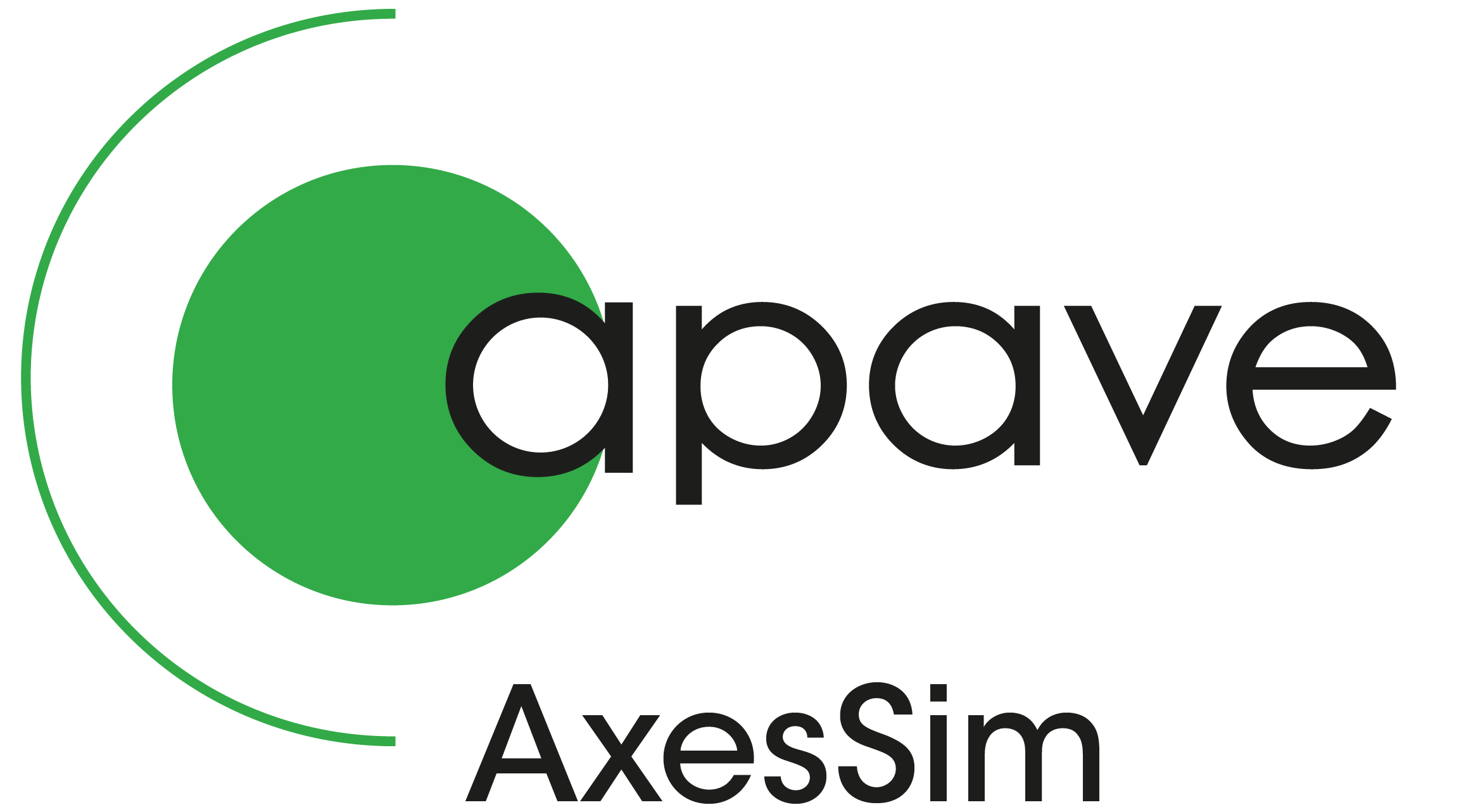Benchmark of Several Linear Algebra Kernels for solving a Laplace Problem
Benchmark of C P.U.L. calculation of a Cable Arrangement for several Linear Algebra Kernels including CPU and GPU implementation.
Introduction
Introduction
The Linear Algebra Kernel is an essential piece in the engineer’s and scientist’s tool box, there are many implementations both specific implementations for special usage and more generic implementations which remain efficient.
Advent of GPU architecture has opened up new horizons and some new linear algebra kernels have emerged. In the ANALYST project a Laplace problem has been optimized in several ways and several kernels have been benchmarked. In particular the well known Intel MKL library is compared to two OpenCL linear algebra implementation. The first using the ViennaCL library and the second using a from scratch implementation.
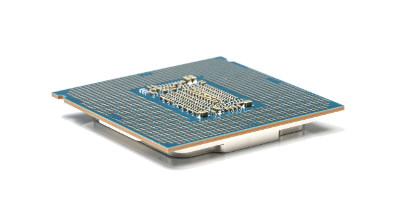
Laplace Problem
Laplace Problem applied to cable harnesses
RLGC matrices of a cable harness depend on its cable arrangement cross-section [5]. To compute these matrices, it is needed to solve the Poisson’s equation in the plane with Dirichlet’s boundary conditions in accordance with the contours of the section conductors.
The potential V allows computing the charge on a conductor by integrating the normal derivative of V.
A set of specific boundary conditions is chosen to compute the capacitance matrix and the inductance matrix by setting the potential to be equal to 1 on one of the conductors and 0 on the others.
The following figure shows the potential on a section made of 18 insulated conductors. Each conductor has been put to an arbitrary-chosen potential. The potential is represented on a uniform grid enclosing the conductors.
The computation complexity of these matrices depends on the number of conductors in the section and the number of base functions on each conductor.
The costy part in computation time of the execution is the solving of linear systems. Three linear algebra kernels have been tested: an internal solver using OpenCL and implementing a Gauss elimination coded from scratch, ViennaCL and MKL.
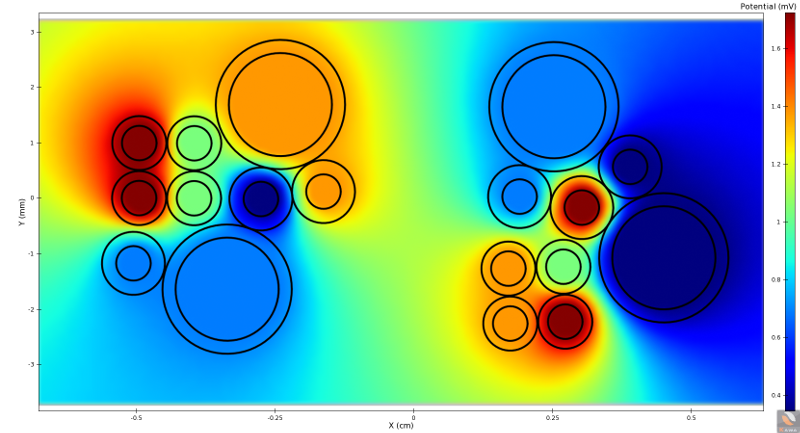
Performance
Computation time Performance
We use these linear algebra kernels on several hosts. The following table gives the specification of these hosts.
Name CPU GPU Comment
1Y-IWS Intel Core i5-9500 (RAM: 32GB) GeForce GTX 1050 (RAM: 4GB) Intel Work Station 1Y-AWS AMD Ryzen 7 2700 (RAM: 32GB) Nvidia GeForce 1660 Ti (RAM: 6GB) AMD Work Station 4Y-WS Intel Core i7-5820K (RAM: 48GB) NVIDIA GeForce GTX 1070 (8GB) Work Station 1Y-CN Intel Xeon Gold 6230 (RAM: 768GB) N.A. Home cluster node oriented bandwidth 8Y-CN Intel Xeon E5-2650 v4 (RAM: 504GB) Nvidia GeForce 1080 Ti (RAM: 12GB) Old Home cluster node
Here is the computation time in seconds of several sections containing up to 700 conductors.
The internal linear solver and the ViennaCL solver have been used with a NVIDIA GeForce GTX 1660 Ti GPU. The MKL is used with an AMD Ryzen 7 2700 CPU.
Size OpenCL from scratch (double) ViennaCL (double) MKL (double) OpenCL from scratch (float)
ViennaCL (float) MKL (float) 5 0.20 0.13 0.07 0.20 0.12 0.04 10 0.39 0.23 0.16 0.34 0.22 0.14 35 2.42 0.96 0.88 2.05 0.86 0.77 70 9.81 3.47 3.61 88.32 3.01 2.95 350 522.1 141.8 171.3 422.4 104.8 97.7 700 N.A. N.A. 1142.2 N.A. N.A. 611.9
On this platform, the Intel MKL is the linear algebra for small configurations.
For intermediate configurations ViennaCL and Intel MKL are competitive. The from scratch Gauss elimination implementations are generally the least efficient.
Finally, for huge configurations, the GPU implementation is limited by the maximal size of a buffer. The case containing 700 conductors can only be executed on the CPU with the Intel MKL.
We can also examine the worst and best computation times for each test case across all hosts.
The following table presents these times in seconds. These results confirm the previous conclusion even if they nuance them a little.
Number of conductors Worst MKL Best MKL Worst ViennaCL Best ViennaCL Worst Gauss Best Gauss 5 0.64 0.02 1.00 0.08 1.11 0.14 10 0.79 0.13 1.21 0.19 1.28 0.31 35 1.58 0.60 2.22 0.95 3.28 2.14 70 4.35 2.13 5.90 3.36 11.26 9.43 350 156.62 68.41 235.57 140.60 942.04 402.00 700 970.20 289.87 N.A. N.A. N.A. N.A.
The next figures represent these times and the speed up regarding the best time we could achieve before optimization developed during the ANALYST project. We can see that, even if we consider the best results as a reference time, we can now compute the RLCG matrices always with a positive gain. The best time of computation is obtained with MKL kernels with a speedup up to 6.
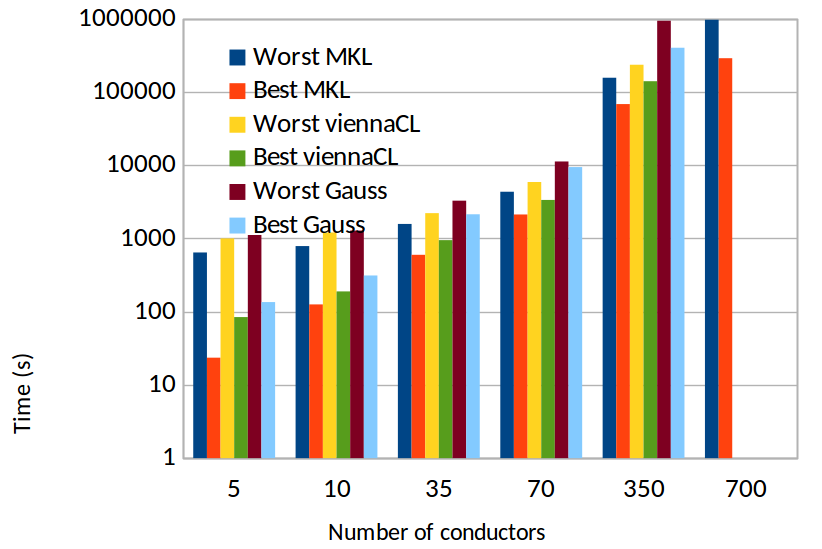
Fig. 2 – Best and worst times of the computation of the RLCG matrices with the different linear algebra kernels depending on the number of conductors. The y-axis is represented as a log scale.
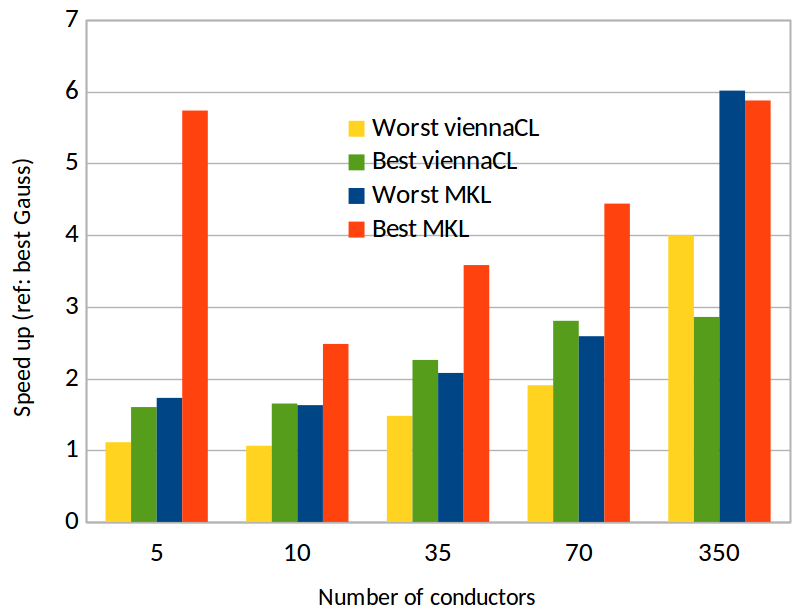
Fig. 3 – Speed up of the computation of the RLCG matrices with the different linear algebra kernels depending on the number of conductors. The reference times are the best and worst times of computation using the Gauss-elimination kernel, that is the best and worst times we could achieve at the beginning of the Analyst project.
We can also examine which machine provides the best and worst times of computation.
We can see the size of the problem changes according to which machine has the best performances. In particular, the available RAM on the GPU has an important impact. In small cases (up to 70 conductors), the GPU with smaller RAM has the best performances, but with larger cases, the GPU with larger RAM has the best performances.
For the CPU, the recent Intel CPU has the best performances, because the Intel MKL is developed by Intel and benefits from a higher level of optimization on this kind of CPU.
Number of conductors Worst MKL Worst ViennaCL Worst Gauss Best MKL Best ViennaCL Best Gauss 5 8Y-CN 8Y-CN 8Y-CN 1Y-IWS 1Y-IWS 1Y-IWS 10 8Y-CN 8Y-CN 8Y-CN 1Y-IWS 1Y-IWS 1Y-IWS 35 8Y-CN 8Y-CN 8Y-CN 1Y-IWS 1Y-IWS 1Y-IWS 70 8Y-CN 8Y-CN 1Y-IWS 1Y-IWS 1Y-AWS 1Y-AWS 350 1Y-AWS 1Y-IWS 1Y-IWS 1Y-IWS 1Y-AWS 8Y-CN 700 1Y-AWS 1Y-CN
These times of computation have been obtained on workstations and machines dedicated to computation. On a laptop, the tendency is somehow similar, but in larger cases, the ViennaCL kernel achieves better performances.
Finally, this shows that the MKL is the best alternative in most cases, except when the CPU has a low number of cores. In this case, using the ViennaCL library allows achieving good performance.
Conclusion
Conclusion
The performance of linear algebra kernel implementation is strongly impacted by the host architecture (CPU architecture, type of RAM, GPU memory and GPU generation). Therefore there is no major tendency to identify the best kernel implementation. A dynamic strategy has finally been chosen to pick the best kernel at run time. This way we have a speedup from 2 up to 6 for a representative host architecture sample.
Despite the fact that there is no big trend, we note that the CPU libraries remain very competitive for this type of problems especially for small issues (not waiting) and for important difficulties (memory limit of GPUs).
Acknowledgment
Acknowledgment
This project has received funding from the Clean Sky 2 Joint Undertaking of the European Union’s Horizon 2020 research and innovation program under grant agreement No 821128.
